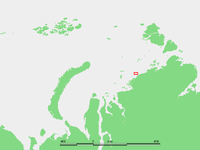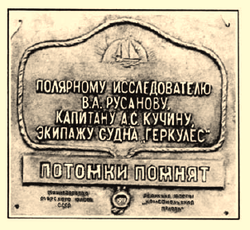
Mona Islands
Encyclopedia


Kara Sea
The Kara Sea is part of the Arctic Ocean north of Siberia. It is separated from the Barents Sea to the west by the Kara Strait and Novaya Zemlya, and the Laptev Sea to the east by the Severnaya Zemlya....
, about 30 km north of the western coast of the Taymyr Peninsula
Taymyr Peninsula
The Taymyr Peninsula is a peninsula in the Far North of Russia, in the Siberian Federal District, that forms the northernmost part of mainland Eurasia and Asia...
in Siberia
Siberia
Siberia is an extensive region constituting almost all of Northern Asia. Comprising the central and eastern portion of the Russian Federation, it was part of the Soviet Union from its beginning, as its predecessor states, the Tsardom of Russia and the Russian Empire, conquered it during the 16th...
, Russia
Russia
Russia or , officially known as both Russia and the Russian Federation , is a country in northern Eurasia. It is a federal semi-presidential republic, comprising 83 federal subjects...
.
The sea surrounding the Mona Islands is covered with pack ice in the winter, which is long and bitter. There are numerous ice floes even in the summer. Kravkov Island (Остров Кравкова) is one of the biggest islands, but it is still only about 3 km square.
Small Gerkules Island (Остров Геркулес), located in the middle of the group, is named after lost explorer Vladimir Rusanov
Vladimir Rusanov
Vladimir Alexandrovich Rusanov was an experienced Russian geologist who specialized in the Arctic.In 1909–1911 V. A. Rusanov carried out explorations in Novaya Zemlya. He was helped by Tyko Vylka, his guide, who later became the Chairman of the Novaya Zemlya Soviet.In 1912 Rusanov had been...
's ship.
Ringnes Island (Остров Рингнес) located at the western end of the group, was named after the Norwegian Ringnes
Ringnes
Ringnes is the largest brewer in Norway.-History:Ringnes AS was founded in 1876. The company's brewery in the Grünerløkka district of Oslo produced its first beer in 1877. The brewery was founded by brothers Amund and Ellef Ringnes together with financial director Axel Heiberg...
brewery that financed Otto Sverdrup
Otto Sverdrup
Otto Neumann Knoph Sverdrup was a Norwegian sailor and Arctic explorer.-Early and personal life:...
's Arctic expeditions. Other islands are called Granitnyy (Остров Гранитный) and Krainiy (Остров Крайний).
The Mona Islands were named by Fridtjof Nansen
Fridtjof Nansen
Fridtjof Wedel-Jarlsberg Nansen was a Norwegian explorer, scientist, diplomat, humanitarian and Nobel Peace Prize laureate. In his youth a champion skier and ice skater, he led the team that made the first crossing of the Greenland interior in 1888, and won international fame after reaching a...
after Henrik Mohn
Henrik Mohn
Henrik Mohn was a Norwegian astronomer and meteorologist. Although he enrolled in theology studies after finishing school, he is credited with founding meteorological research in Norway, being a professor at the Royal Frederick University and director of the Norwegian Meteorological Institute from...
, a Norwegian meteorologist. Mohn worked out and published the meteorological observations of various polar expeditions, including those of Nansen in the "Fram" (1893-6). "Mona" is a genitive case in Russian, meaning "(islands) of Mon" and this name has stuck, especially since the Germans used ("Mona Inseln"), based on the Russian version of the name, during their campaigns in World War II
World War II
World War II, or the Second World War , was a global conflict lasting from 1939 to 1945, involving most of the world's nations—including all of the great powers—eventually forming two opposing military alliances: the Allies and the Axis...
. Since then "Mona Islands" has become popular and its use has been widespread in this manner for many decades and in many modern maps and atlases. "Mohn Islands", which would be the grammatically correct way of naming these islands in English, is so rare that there are practically no maps now where the name "Mona" is not used.
This island group belongs to the Krasnoyarsk Krai
Krasnoyarsk Krai
Krasnoyarsk Krai is a federal subject of Russia . It is the second largest federal subject after the Sakha Republic, and Russia's largest krai, occupying an area of , which is 13% of the country's total territory. The administrative center of the krai is the city of Krasnoyarsk...
administrative division of the Russian Federation.
History

Russia
Russia or , officially known as both Russia and the Russian Federation , is a country in northern Eurasia. It is a federal semi-presidential republic, comprising 83 federal subjects...
n scholars deem that Vladimir Rusanov and his ill-fated party disappeared somewhere around the area of the Mona Islands. Relics were found in 1934 in Gerkules Island, including a wooden pole with the inscription "Gerkules 1913", broken old sledges and a fragment of a cartridge box. Other remainders were found in Popova Chukchina, an island of another group not far away (Kolosovykh Islands
Kolosovykh Islands
The Kolosovykh Island is a island, in the Kara Sea off the coast of Siberia.This coastal archipelago, is located north of the small Kolosovykh peninsula, which is almost an island itself. This island group is located between 74° 45' and 75° N and between 85° and 87° 30'E...
) during and expedition organized in 1937 by the Arctic Institute
Arctic and Antarctic Research Institute
The Arctic and Antarctic Research Institute, or AARI is the oldest and largest Russian research institute in the field of comprehensive studies of Arctic and Antarctica...
of the Soviet Union
Soviet Union
The Soviet Union , officially the Union of Soviet Socialist Republics , was a constitutionally socialist state that existed in Eurasia between 1922 and 1991....
.
During the Second World War
World War II
World War II, or the Second World War , was a global conflict lasting from 1939 to 1945, involving most of the world's nations—including all of the great powers—eventually forming two opposing military alliances: the Allies and the Axis...
there was much activity near these lonely islands. Kriegsmarine
Kriegsmarine
The Kriegsmarine was the name of the German Navy during the Nazi regime . It superseded the Kaiserliche Marine of World War I and the post-war Reichsmarine. The Kriegsmarine was one of three official branches of the Wehrmacht, the unified armed forces of Nazi Germany.The Kriegsmarine grew rapidly...
heavy cruiser Admiral Scheer, under Commander Wilhelm Meendsen-Bohlken
Wilhelm Meendsen-Bohlken
Wilhelm Gerhard Oskar Julius Meendsen-Bohlken was a Vizeadmiral with the Kriegsmarine during World War II and a recipient of the Knight's Cross of the Iron Cross...
, destroyers Friedrich Eckoldt, Erich Steinbrinck and Richard Beitzen
German World War II destroyers
At the outbreak of the Second World War, the German Navy, the Kriegsmarine, had 21 destroyers . These had all been built in the 1930s, making them modern vessels...
, entered the Kara Sea along with submarines U 601 (Captain Grau) and U 251 (Lt. Captain Timm) in August 1942, in order to destroy Soviet warships.
The Germans knew that many ships of the USSR fleet had sought refuge in the Kara Sea because of the protection that its icy pack provided during ten months in a year. The large-scale naval operation in order to enter the Kara Sea and destroy as many Russian vessels as possible was named Operation Wunderland
Operation Wunderland
Operation Wunderland was a large-scale operation undertaken in summer 1942 by the Kriegsmarine during World War II in the waters of the Northern Sea Route close to the Arctic Ocean...
.
Since May 1993 the Mona Islands are part of the Great Arctic State Nature Reserve
Great Arctic State Nature Reserve
The Great Arctic State Nature Reserve is a nature reserve in Krasnoyarsk Krai, Russia...
, the largest nature reserve of Russia.
See also
- Kara SeaKara SeaThe Kara Sea is part of the Arctic Ocean north of Siberia. It is separated from the Barents Sea to the west by the Kara Strait and Novaya Zemlya, and the Laptev Sea to the east by the Severnaya Zemlya....
- Kolosovykh IslandsKolosovykh IslandsThe Kolosovykh Island is a island, in the Kara Sea off the coast of Siberia.This coastal archipelago, is located north of the small Kolosovykh peninsula, which is almost an island itself. This island group is located between 74° 45' and 75° N and between 85° and 87° 30'E...

